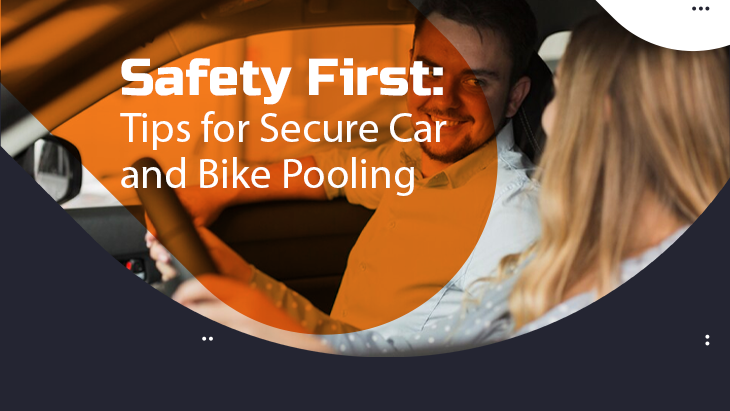Safety First: Tips for Secure Car and Bike Pooling

Posted on: 22 July, 2024
In today’s fast-paced world, car and bike pooling have emerged as popular and efficient solutions for commuting with Trip-Tie. Not only do they help reduce traffic congestion and pollution, but they also offer a cost-effective way to travel. However, like every mode of transportation, safety remains a paramount issue. Whether you're sharing a trip to work or school or cycling together for entertainment, it's essential to prioritize protection for all participants. Here are some comprehensive guidelines to ensure secure car and bike pooling trips.
Understanding the Basics
Before diving into specific safety tips, it’s important to understand what car-bike sharing entails. Carpooling involves sharing a ride with one or more people to reduce individual travel costs, while bikepooling typically involves groups of cyclists travelling together for safety and a new friendship that promotes efficiency and reduces the environmental footprint.
Safety Tips for Carpooling
Choose your Companions Wisely
Know Your Fellow Travelers: Whether you’re the driving force or a passenger, it's crucial to understand who you’re travelling with. Utilize carpooling apps or services that require historical background checks and personal opinions to choose reliable partners.
Meet in Public Places: For the initial conferences, choose properly lit and public places. This ensures each party's experience is steady and may determine the difference in a secure environment.
Plan the Route in Advance
Shared Route Knowledge: Ensure that each passenger is privy to the course and any planned stops. Sharing your route with a dependent pal or member of the family can offer a further layer of safety.
Avoid Isolated Areas: Stick to properly travelled roads and avoid secluded routes, particularly for the duration of night-time journeys.
Vehicle Safety Checks
Regular Maintenance: The car must be in the right operating circumstances. Regular exams on brakes, tyres, and lights are important to prevent any breakdowns or injuries.
Emergency Kit: Keep an emergency kit within the automobile, inclusive of items like a primary-useful resource kit, a flashlight, water, and simple tools. This may be precious in the event of unforeseen incidents.
Communication is Key
Stay Connected: Keep your cellphone charged and feature emergency contact numbers effortlessly to be had. Inform someone approximately of your journey details, inclusive of the time of departure and anticipated arrival.
Agree on Ground Rules: Discuss and agree on carpooling rules in advance, consisting of smoking guidelines, tune choices, and any cost-sharing preparations. Clear communication facilitates staying away from misunderstandings and guarantees a smoother journey.
Safety Tips for Bike Pooling
Park your Bike Properly
Routine maintenance: Make sure your bike is in top condition. Check the brakes, tire pressure, and lights regularly. A well-maintained bicycle is less likely to have an accident.
Safety Equipment: Always wear a helmet and consider additional safety equipment such as gloves and reflective clothing. In low-light conditions, ensuring visibility becomes crucial.
Know the Path
Plan: Know the route thoroughly, including any potential hazards or difficult sections. Share this information with your fellow cyclists to make sure everyone is prepared.
Use designated bike lanes: Stick to designated bike lanes and routes whenever possible. These roads are generally safe and bike-friendly.
Ride in Order
Single file or sideways: Decide whether to stay single file or sideways based on the road or road width. In multiple formats, a single file is usually protected.
Provide safe lanes: Provide safe distances between bikes to avoid collisions. Observe your surroundings and report changes in course or speed to the team.
Communicate Clearly
Hand signals: Use clear hand signals to signal speed changes, stops, or turns. Consistent communication is key to team safety.
Use technology: Consider using bike radios or apps designed for cyclists to stay connected while riding. This can be especially useful for long trips or large groups.
General Safety Tips for Both Car and Bike Pooling
Personal Protective Equipment
Emergency contacts: Make a list of emergency contacts and share your travel plans with someone you trust. This lets someone know where you are.
Keep informed: Keep informed of any weather and travel advisories that may affect your trip. Adjust policies accordingly to avoid unnecessary risks.
Insurance and Legal Considerations
Check insurance policies: Make sure your car insurance covers car pooling. If you want a collector bike, check if your health or bicycle insurance covers group biking.
Know your rights and responsibilities: Familiarize yourself with local laws regarding car-bike sharing. Compliance with these laws provides legal protection and enhances safety.
Be Prepared for Emergencies
First Aid Skills: For minor injuries or accidents, basic first aid skills can be invaluable. If you haven’t already, consider taking a first-aid course.
Emergency Plan: Make a clear emergency plan. Know the locations of nearby hospitals or clinics and have a way to get in touch with help if needed.
Conclusion
Car and motorcycle pooling are notable methods to keep cash, lessen environmental impact, and make commuting more fun. However, safety has to constantly be the pinnacle of precedence. By following those pointers and keeping open communication with your tour companions, you may ensure a stable and first-class experience for everyone concerned. Remember, touch preparation and vigilance can go a long way toward stopping injuries and ensuring a smooth adventure. So, the next time you propose to carpool or motorcycle pool, keep these safety guidelines in mind and experience a more secure, extra-efficient journey.


